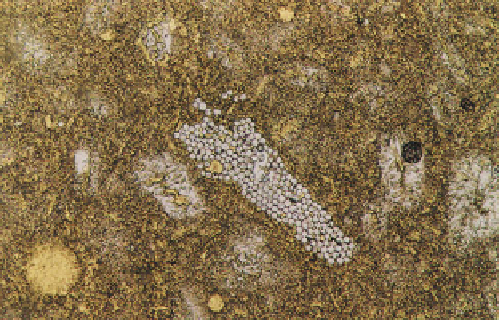Geoscience Reference
In-Depth Information
plasters. Reducing the density of plaster products has a
number of advantages including lower transport costs,
less effort to mix/apply, it can be used in thicker layers
(without sagging), and it has improved thermal insulation
and fire resistance properties.
Lime may be used in quantities of up to 25% in certain
finishing plasters, to improve working properties of the
fresh material and to reduce corrosion of embedded
metals (by increasing alkalinity). Undercoat plaster
intended for high suction backgrounds might include
cellulose fibres to improve water retention.
Historic plasters and those used for restoring historic
buildings may be reinforced using animal hair, sisal,
straw, or chopped reed (
276
). Modern precast plaster
products may incorporate reinforcing fibres such as
chopped fibre glass (
277
). Glass fibre and fire retardant
additives may also be added to improve fire protection
performance.
Chemical additives such as sugar, starch, alum, and
potassium/zinc sulfate are added to gypsum plaster as
accelerators and retarders. These are not visible
microscopically and, as they are usually only present at
levels of 0.5-1%, they are also difficult to detect by
chemical analysis. It has been found that certain
chemical additives can reduce the strength of plaster by
detrimentally changing the shape of the set gypsum
crystals and their interlocking structure (Prakaypun &
Jinawath, 2003). It is also reported that the use of
carboxylic acid retarder can improve the durability of
repair mixes for historic gypsum-based mortar, by
increasing density and lowering capillary porosity
(Middendorf, 2001).
plastering. Other plasterboard varieties include those with
foil backing or bonded layers of polystyrene/glass fibre
to improve thermal insulation, or a polythene backing
for improved vapour resistance. Figure
278
shows the
typical aerated texture of plasterboard.
P
LASTER DEFECTS
Petrographic examination is called upon to investigate a
variety of issues related to gypsum plasters and
associated plastering defects. One of the most common is
whether the plaster material used is the one that was
specified. This can usually be achieved by microscopical
276
276
Particle of chopped reed reinforcement (white) in
historic gypsum plaster. Note the cellular plant
structure; XPT, ×150.
P
LASTERBOARD
Patented in America in 1894, the use of plasterboard as
an internal dry lining finish is a relatively recent
application. It has become popular as an alternative to
plaster finishes because it is cleaner and less labour
intensive than wet plastering and reduces the drying out
time of building construction. Produced by sandwiching
accelerated hemihydrate slurry between paper liners and
then kiln drying, the strength of plasterboard lies in the
heavy paper facing. Gypsum is only required to be low
strength inert filler, preferably with low density.
Reduction in density is usually achieved by air
entrainment, although the incorporation of lightweight
materials such as wood fibre and pumice is known.
Technological advancements mean that a wide variety of
boards is now available to meet an ever-increasing range
of applications. Most boards have one surface (often
ivory coloured) for direct decoration and one surface
(often grey), which has better adhesion properties for
277
277
Gypsum plaster ceiling tile with fibre glass
reinforcement. The fibre (white) is cut obliquely
showing multiple filaments. The gypsum matrix
appears light brown and three voids are lined by
larger laths of gypsum (white); PPT, ×150.





